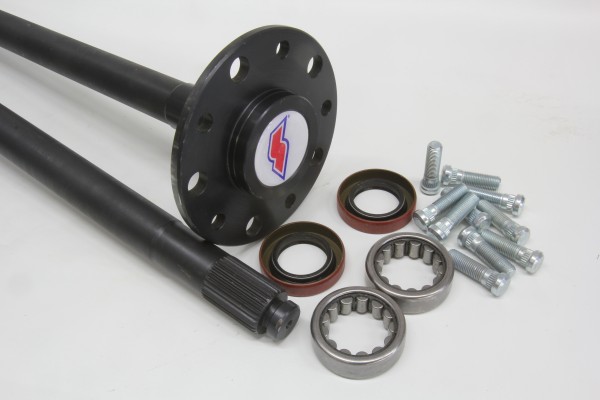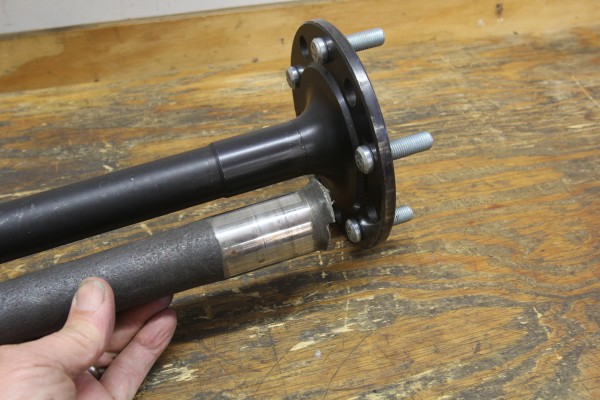[All images/Jeff Smith]
Axles aren’t usually a topic of great discussion—until one fails or otherwise needs replacing.
If you think about these overlooked components, they are often severely abused and then blamed when they fail. Using a big-block Chevelle with a Turbo 400 transmission and 4.10 gears as an example, let’s look at the amount of torque applied to a single axle. Torque converters are aptly named because at the moment when a car sitting on the starting line launches, the converter multiplies the most amount of torque. These multiplication factors can range from 1.8:1 to 2.5:1; let’s use a conservative figure of 2.0:1. This means if our big block Chevelle makes 500 ft.-lbs. of torque at 3,000 rpm, then at the instant the car leaves the starting line, the transmission’s input shaft will be twisted with 1,000 ft.-lbs. of torque. Now let’s multiply that times the first gear ratio of 2.48:1. We now have 2,480 ft.-lbs. of torque transmitted to the rear end. With a 4.10 rear axle gear ratio, our torque jumps to 10,168 ft.-lbs. of twisting motion. Divide that by two axles and each axle is transmitting over 5,000 ft.-lbs. of torque to each rear tire. If the car hooks up, that is a phenomenal amount of twisting motion applied!
There are all kinds of losses that we glossed over in that mathematical adventure, including gear friction in both the transmission and rear gears, but these will be less than 5 percent. We will also assume that a certain amount of tire slip also occurs, but the point is that a phenomenal amount of twisting motion is still going to be applied to each of those rear axles.
Even if you never abuse your axles like this, they deserve attention.
We recently decided to rebuild our ’66 Chevelle’s 12-bolt rear end and needed a set of axles to complete the upgrade. We discovered that Summit Racing’s 12-bolt axles are not only a little less expensive than most everywhere we looked, but they also came with new bearings, seals, and lug studs. That was an offer we couldn’t pass up.
It’s relatively common knowledge that factory style 10- and 12-bolt axles are somewhat spindly. To our surprise, the Summit Racing stock replacement C-clip axles we chose are much higher quality despite their affordable price. The axles are made of induction-hardened 1541H steel, and we noticed the excellent radius transition between the axle itself and the flange. This is where torque concentrates and the greatest bending force is applied, especially if the car is subjected to high speed cornering as in autocross or track events.
We also compared shaft diameter between the Summit Racing axles and stock axles at the mid-point, and discovered the cross-section on the Summit Racing axles to be a full 0.100-inch larger. That’s a big plus for drag racers who need all the axle strength they can get to withstand the shock of all that torque at launch.
Summit Racing carries these axles for the most popular 10- and 12-bolt GM applications like early Camaros and Chevelles, and also for the popular 8.8 inch Ford axles found under Fox body Mustangs. It’s important to note that all of these axle assemblies use an axle bearing that is pressed into the housing. The bearing rides directly on the axle, essentially using the axle shaft as the inner bearing race. The downside to this design is if the bearing should fail, it almost always destroys the axle as well. That’s why Summit Racing supplies new bearings and seals with its axles—and why you should always replace the bearings any time a new axle is installed. This ensures that the new axle will deliver plenty of service life.
Then there’s the subject of replacing the stock C-clip axles with high performance pieces. Most drag racing organizations require that you replace the C-clip axle once you exceed a certain ET and trap speed. The reason for this is safety. A C-clip retains the axle in the innermost portion of the axle housing. If the axle breaks outside that retention point, there is nothing to keep the axle in the housing. That means the axle will slide out of the housing and cause all sorts of damage, and possibly a nasty crash.
There are C-clip eliminator kits on the market, but our experience with these has been less than successful. The usual problem is leakage. This may be acceptable for a low mileage drag car but for a street-driven car, this just won’t work. Plus, the pillow blocks required for these conversions means you can do a rear disc brake conversion. The alternative is to take your housing to a specialist, have them cut off the factory housing end, and weld on a new end that uses the popular 3.150-inch large Ford axle bearing that is pressed on to the axle shaft. The axles now are retained by a four-bolt ring that will keep the axle in the housing should there be a problem. While the conversion will require new axles, it isn’t that expensive and is the best way to upgrade a 12-bolt or 8.8 Ford rear housing.
Armed with a little more information, selecting your next axle upgrade will be a much easier task regardless of whether you are just rebuilding a stock rear end or you have aspirations of being the next 1320 hero.
Parts List
SUM-700121: Summit Racing Direct-Fit Axle Shafts, GM 12-bolt, pair
MSR-7900: Moser Housing Ends, GM 12-Bolt with large Ford bearing conversion
TFS-8510200: Trick Flow Rear-End Cover, GM 12-Bolt
RAT-5104R: Ratech Rear-End Cover Gasket, GM 12-Bolt
KTI-70380: K-Tool Axle Bearing Removal Tool












Thanx. Learned a lot!
I have a 1970 ss Chevelle Axle code says KG 111BDon’t know what that means can you bury help me